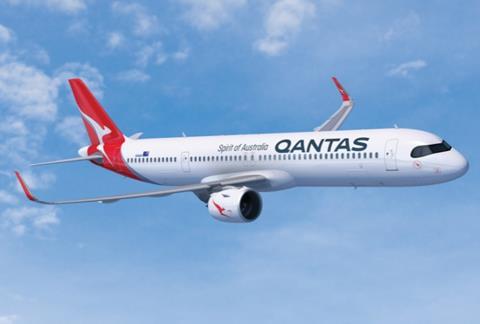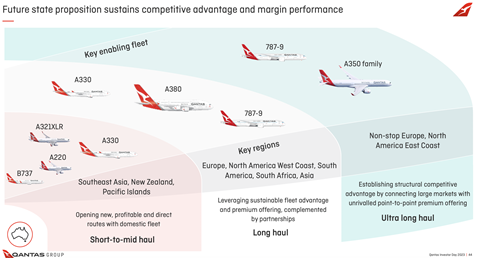Qantas has teased the prospect of expanding its international network as it moves closer to taking delivery of the first of many new aircraft under its long-term fleet renewal programme.
In a 97-page presentation document issued today as part of its investor day, the Oneworld carrier goes to great lengths to detail the competitive advantage its incoming fleet of new jets will offer.

The airline and its low-cost unit Jetstar have close to 300 new aircraft on order, the bulk of them Airbus jets including A220s and A321XLRs. Qantas also has 12 A350-1000s on order, which will eventually operate the ultra-long-haul ‘Project Sunrise’ flights to New York and London.
The arrival of the Airbus widebodies will allow the airline to redeploy its fleet of Boeing 787-9s, currently the mainstay of long-haul operations. In its presentation document, Qantas praised the 787 for its “proven ability to drive [profit] margin through unique point-to-point offerings”.
Citing its London routes as an example, on which it deploys 787-9s non-stop from Perth, Qantas says its strategy of splitting twice-daily operations between a 787 and A380 has “structurally changed” the earnings of the loss-making route.
Qantas adds that other routes where it recently deployed the 787 on, including Perth-Rome and Melbourne-Dallas/Fort Worth have shown “improved earnings”.
It suggests this “repeatable strategy” can be used to potentially open new opportunities, listing cities such as Paris – which it has served in the past – as well as Chicago, where it had intended to fly to before the pandemic struck.
On its future short- to medium-haul fleet, which will comprise A220s and A321XLRs, Qantas says the new jets will jointly “deliver improved mix of range and gauge”. The long-range A321XLRs will deliver a lower cost base than the 737-800s it is replacing, while the A220s “enables increased network frequency” with competitive unit costs versus the 737s.
This will allow the airline “profitable entry” onto routes that were previously unfeasible. While Qantas did not provide any examples, accompanying graphics – showing indicative range maps from Brisbane and Perth – point to destinations like Ho Chi Minh City, Bangkok, Phuket, and Nadi in Fiji.

In another slide showing the make-up of its future fleet, Qantas also appears to be retaining the A330s and A380s for the near-term. The A380s will operate in the long-haul network, while the A330s will fly a mix of medium- and long-haul operations.
As for Jetstar, Qantas says the 15 A321XLRs bound for the low-cost operator will allow it to redeploy its 787s to “new or existing markets” beyond the range of the narrowbody fleet. In the future, Jetstar will deploy its A321LRs on short-haul international routes, while the A321XLRs and 787s will be utilised on medium-haul and long-haul flights.
Qantas cites several network opportunities for Jetstar with the new fleet make-up: including to Sri Lanka, the Pacific Islands, as well as South Korea and the Philippines.


























